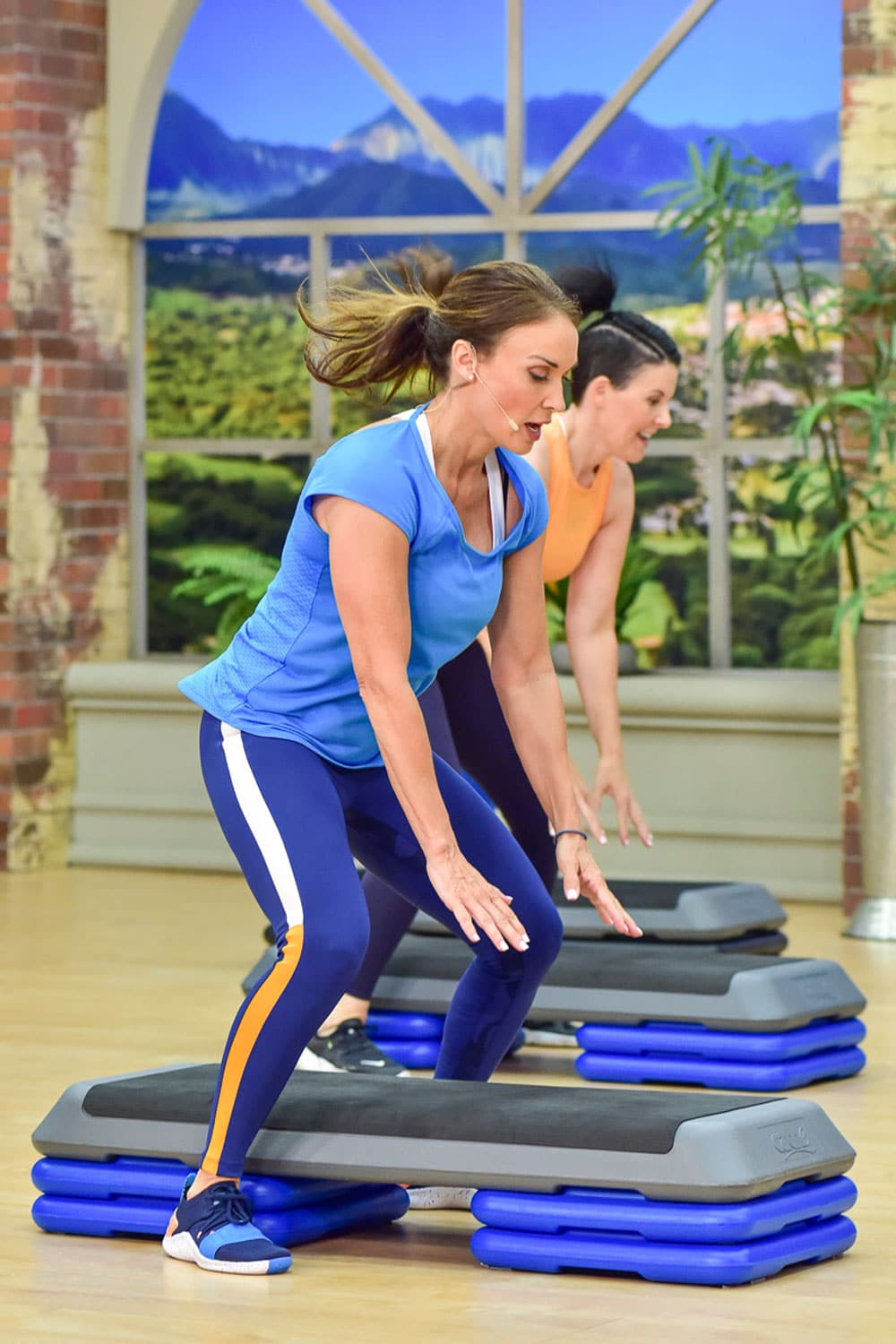A phenomenon has been sweeping across gyms and exercise routines – the rise of high-intensity interval training, or HIIT for short. This dynamic approach has captured the attention of fitness enthusiasts worldwide, offering an efficient and effective way to challenge the body. But get ready to sweat!
HIIT is an approach to exercise that alternates short bursts of intense movement followed by periods of rest or lower-intensity activity to allow your muscles (and breathing) to recover. It’s customizable too. You can include a variety of exercises in a HIIT workout – plyometric movements, cycling, running, climbing stairs, kettlebell swings, and more.
The beauty of HIIT is how efficient this workout approach is. You can get into tip-top shape in a fraction of the time compared to traditional steady-state cardio. It’s also a calorie-torching powerhouse. Studies show HIIT workouts burn 25-30% more calories than moderate-intensity workouts.
More Benefits of HIIT
Plus, because you’re pushing your body hard, it must expend more energy to recover. Therefore, HIIT stimulates your metabolism So once you’ve finished that sweaty workout, you burn calories long after you’ve cooled down and are quietly sipping a recovery beverage.
HIIT is a workout for your heart muscle too. Doing HIIT workouts regularly will enhance your cardiovascular health and boost your V02 max. (the amount of oxygen your body can utilize during exercise). Depending on the exercises you choose, you can build muscle strength or endurance with HIIT. And you’ll also encourage your body to shed those stubborn pounds of body fat. Bonus: Your insulin sensitivity will improve too.
And talk about diverse! You can create HIIT workouts using your choice of exercises, from sprinting and cycling (for a cardiovascular focused approach) to kettlebell swings and squat jumps (to increase strength and power). This means you can tailor your HIIT sessions to suit your goals and preferences. So, it’s customizable and versatile.
But as with any form of high-intensity exercise, don’t jump into HIIT before you’re ready. Let’s look at strategies to approach a HIIT workout safely and effectively.
Check with Your Doctor
Before lacing up your sneakers and launching into your first high-intensity workout, check with your healthcare provider if you have any pre-existing medical conditions or are new to exercise and over the age of fifty. While HIIT can be an incredible tool for improving your fitness, it’s also demanding and places stress on your cardiovascular system. Your doctor can help determine if HIIT is safe for you and give you guidance on how to approach it based on your health and lifestyle. Think of it as giving your body the green light before embarking on your HIIT journey – a way to make it a safe and effective workout experience.
Master Your Form
Mastering proper form and technique is necessary. You don’t want to be sidelined by an injury you could have prevented. Poor form is a common cause of HIIT-related injuries so learn how to execute each movement correctly.
Learn to engage the right muscles, maintain good posture, and move with control and awareness. If something doesn’t feel right, modify the movement, or lower the intensity until you feel like you’ve mastered it. This will help you avoid common mistakes that could lead to injury down the road.
Warm-Up Properly
Before you jump into your HIIT session, don’t forget the warm-up. Warming your muscles and joints up is like giving them a gentle wake-up call. You’re getting them primed for the intense work ahead. So, what comprises a good warm-up?
Do a combination of dynamic stretches and light cardio to get your blood flowing and muscles warm. Dynamic stretches involve moving your muscles and joints through a range of motion, rather than holding a stretch statically. Think walking lunges, leg swings, and arm circles – movements that mimic the exercises you’ll be doing in your HIIT session.
A few minutes of jogging, jumping jacks, or even dancing to your favorite tunes will prime your heart and lungs for action. Start slowly and gradually increase your intensity, giving your body time to adjust to the demands of the workout ahead.
Start with a Lower Intensity and Build Up
When you first start HIIT, don’t go all-out right from the get-go. Begin at an intensity that challenges you but still allows you to maintain proper form. As your fitness improves and your body adapts to the demands of HIIT, slowly crank up the intensity. That could mean adding an extra round to your circuit, shortening your rest periods, or boosting the resistance on your exercises. Listen to your body and progress at a pace that feels challenging but sustainable. Remember, HIIT is a journey, not a destination – so embrace the process and celebrate each small victory along the way.
Make Time for Recovery
Let’s not forget about rest and recovery. Giving your body time to recover is just as important as the workout itself. Think of your HIIT sessions as a series of tiny earthquakes for your muscles. Each intense interval creates microscopic tears in your muscle fibers, that when repaired, boost strength and endurance. Rest is important for the recovery process. It’s best to avoid doing high-intensity training more than 2-3 times per week.
And don’t forget – “rest” doesn’t mean sitting on the couch all day. An active recovery, like gentle yoga, walking, or swimming, will increase the blood flow to your muscles while still allowing your muscles to repair and your body to recover.
Skipping rest days might seem like a fast track to faster results but quite the opposite. Too little rest between sessions will slow your progress, as you’ll have residual fatigue that limits your performance. So, embrace your rest days – your body (and your future HIIT sessions) will thank you for it.
Listen to Your Body
HIIT is supposed to be challenging but not torturous. If you feel exhausted or have symptoms like dizziness, nausea, or sharp pain, that’s your body waving a big red flag. So, step it back a notch. If you need to, modify exercises. For example, if burpees make you feel like you’re going to pass out, try step back into a plank position instead of jumping. Or, if your legs are feeling like jelly during jump squats, do bodyweight squats instead.
And if you need to take a break, do so. Take a few extra seconds of rest between intervals or even cut your workout short if you’re struggling to make it through an interval. It’s okay to scale back your intensity from time to time. You may have had an exhausting day and need to modify. The most important thing is to stay in tune with your body and give it what it needs to thrive.
Conclusion
Do HIIT training but do it the right way. It’s an efficient and effective way to work out. Enjoy!
References:
- Tinsley G. 7 Benefits of High Intensity Interval Training (HIIT). Healthline. Published June 2, 2017. Accessed April 28, 2024. https://www.healthline.com/nutrition/benefits-of-hiit
- “Evidence-Based Effects of High-Intensity Interval Training on Exercise Capacity and Health: A Review with Historical Perspective.” 05 Jul. 2021, https://www.ncbi.nlm.nih.gov/pmc/articles/PMC8294064/.
- “High Intensity Interval Training for Maximizing Health Outcomes.” https://pubmed.ncbi.nlm.nih.gov/28385556/.
- “High intensity interval training (HIIT): Benefits and how to start.” 13 Jan. 2020, https://www.medicalnewstoday.com/articles/327474.
Related Articles By Cathe:
The Science Behind HIIT: How It Improves Cardiovascular Fitness and Burns Fat
5 Ways to Maximize the Benefits of HIIT without Injury or Overtraining
What Type of Exercise is Best for Improving Aerobic Capacity? Hint: It’s Not Jogging
High-Intensity Interval Training: How Intense Does It Have to Be?
Is Being Aerobically Fit Key to Longevity?
How Accurate Is Maximum Heart Rate for Measuring Exercise Intensity?
What Role Does Aerobic Capacity Play in Successful Aging?
Why Does Aerobic Capacity Go Down as You Age?
Aerobic Fitness Test: How to Measure Your Aerobic Capacity
5 Factors That Determine a Person’s Aerobic Capacity
Is It Ever Too Late to Improve Your Aerobic Fitness Level?


